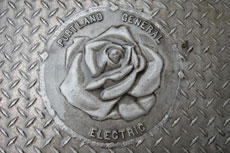Human Flower Project
Tuesday, November 29, 2005
Adventskranz
With evergreens and candles, advent wreaths build anticipation of December 25
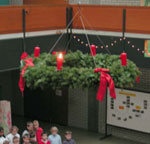 Lighting the Adventskranz
Lighting the Adventskranz
Photo: Johann Peter Heber School
Thanks to John Stokes, long-distance friend and faithful steward of Mary’s Gardens, for sending this piece from ZENIT: an interview with Father Juan Javier Flores Arcas, rector of the Pontifical Liturgical Institute of St. Anselm in Rome, about the meaning of the Advent wreath.
On the Sunday closest to November 30 (the Feast of St. Andrew), these circles of greenery are brought into houses and churches, and the first of four candles is lit. The custom in our Episcopal Church was to light one more candle each Sunday until Christmas. On December 25, all four would shine.
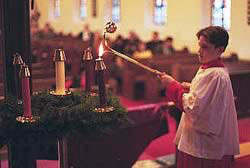 Catholic Community of Pleasanton, CA
Catholic Community of Pleasanton, CA
Photo: via St. Nicholas Center
According to Father Arcas, purple is “most appropriate” for the candles, this color being both regal and penitential. The wreath itself, he says, “must be placed in a visible place in the presbytery—very near the altar, very near the pulpit—on a small table, or the trunk of a tree or hung from the ceiling.” Interesting, how the tree slips in.
Lighting candles and logs with the approach of Winter solstice is a custom far older than Christianity. A strong fire could lengthen winter days and ward off icicles, much appreciated in the high latitudes of Scandinavia. Lights at four points of the compass and green boughs bent into a circle suggest an ancient pagan custom, but according to a couple of sources, the Advent wreath (known in its native Germany as Adventskranz) is relatively modern. Wikipedia credits Johanes Hinrich Wichern, a Protestant minister, with designing the first one. He was running an orphanage in 19th century Hamburg, Germany, and surely trying to contain the children’s excitement. It’s said that the first wreath held 28 candles, four “Sunday” ones taller than the rest. With each passing day, another candle would be lit, until the whole wreath shone on Christmas. (The Advent calendar, also of German origin, likewise builds suspense day-by-day.)
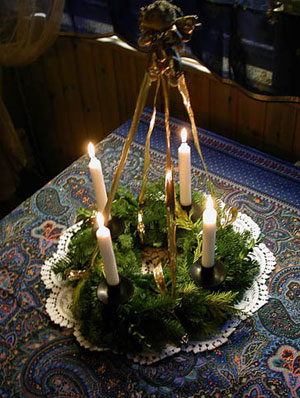 Advent wreath
Advent wreath
Photo: Odla
While in the U.S., one most often finds Advent wreaths in churches or schools, in Germany it’s also become customary to have such a wreath at home. “We always had an advent wreath when I was growing up,” writes Carol Lehr. “Right before bedtime my brothers and I gathered around the wreath and we each took turns lighting the candle(s) and reading the bible verses. I can’t, in all honesty, say that as a child I appreciated the tradition. But I must have gotten something from the practice because I carried on the same custom with my children.” More evidence that the juice of tradition is in the passing as much or more than in the practice.
Writer Ken Collins takes an especially down-to-earth approach: “Historically, the candles have no more meaning than a countdown. That is, they originally stood for 4, 3, 2, and 1. However, people like for things in the church to have symbolic meanings,” he writes, and goes on to specify for us those associations. As Collins suggests, this is custom in its late mannerist phase, the same kind of symbolic filigree that emerged with “the language of flowers.”
“If someone in your church tells you that the candles have some other meaning than Hope, Love, Joy, or Peace, they aren’t wrong, they are just different,” he advises. “The meanings are so new,”—so superfluous and arbitrary, we might add—“that they aren’t completely standardized.”
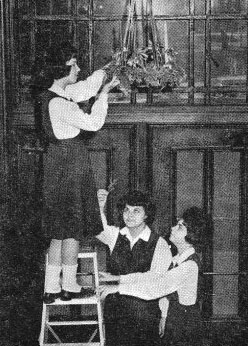 St. Anthony High School
St. Anthony High School
Detroit, MI (1961)
Collins alludes to Advent’s older, more solemn mood—before the piping in of “ring-ting-tingling,” etc. In keeping with this penitential spirit, there were to be no flowers on the Advent wreath (December in Germany isn’t known for its blooms anyway). The third Sunday in Advent, however, was known as Gaudette Sunday, a day to lighten up on austerity. According to Collins, priests would change their vestments from dreary purple to rose on this day; and “the pope had the custom of giving someone a rose,” late in the Advent season. John, do you know any more about this papal custom?
While the Adventskranz does seem to have originated among German Lutherans, it’s now a custom observed by Presbyterians in Alabama, Episcopalians in California, Anglicans in Melbourne. Perhaps because it’s not bound to Christian liturgy, the Adventskranz crops up and lights up in schools, hotels, and even on the German airline Lufthansa.
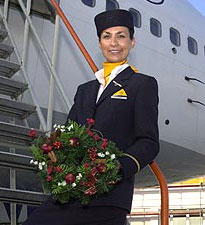 Adventskranz aboard
Adventskranz aboard
Photo: Lufthansa
“There are seven on each jumbo jet,” we learn, “adorned with apples, cinnamon sticks, pyracantha and other greenery, and festive red bows.”
And why not? Father Arcas says, “Advent is a live and actual time. While we hear the still unfulfilled prophecies, we see the world pass before our eyes and long for the world to come…”
…where, along with lights and greenery, there will be flowers.
Culture & Society • Religious Rituals • Secular Customs • Permalink
